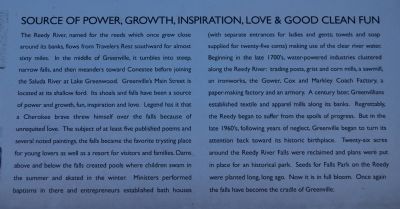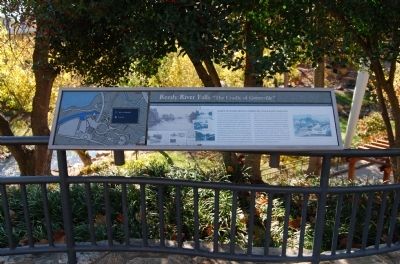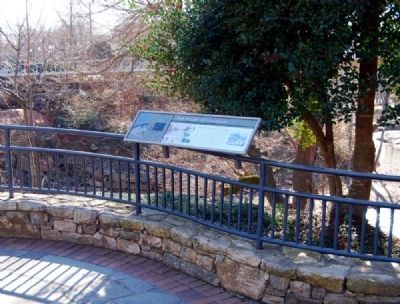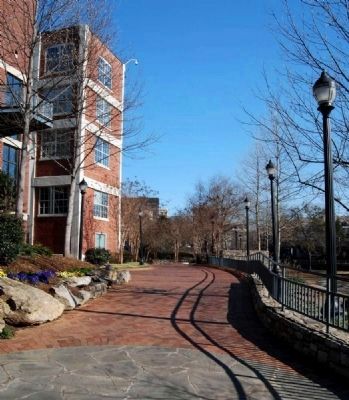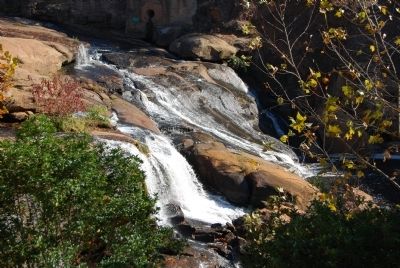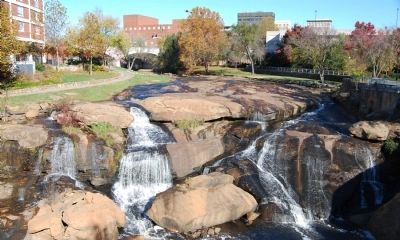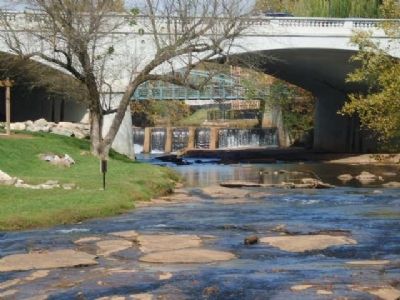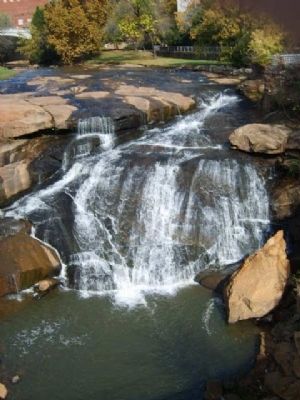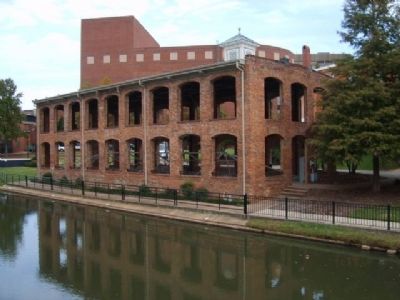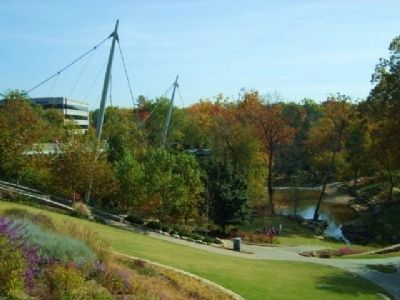Greenville in Greenville County, South Carolina — The American South (South Atlantic)
Reedy River Falls
The Cradle of Greenville
Source of Power, Growth, Inspiration, Love & Good Clean Fun
The Reedy River, named for the reeds which once grew close around its banks, flows from travelers Rest southward for almost sixty miles. In the middle of Greenville, it tumbles into steep, narrow falls, and then meanders toward Conestee before joining the Saluda River at Lake Greenwood. Greenville's Main Street is located at its shallow ford. Its shoals and falls have been a source of power and growth, fun, inspiration and love. Legend has it that a Cherokee brave threw himself over the falls because of unrequited love. The subject of at least five published poems and several noted paintings, the falls became the favorite trysting place for young lovers as well as a resort for visitors and families. Dams above and below the falls created pools where children swam in the summer and skated in the winter. Ministers performed baptisms in there and entrepreneurs established bath houses (with separate entrances for ladies and gents; towels and soap supplied for twenty-five cents) making use of the clear river water. Beginning in the late 1700's, water-powered industries clustered along the Reedy River: trading posts, grist and corn mills, a sawmill, an ironworks, the Gower, Cox and Markley Coach Factory, a paper-making factory and an armory. A century later, Greenvillians established textile and apparel mills along its banks. Regrettably, the Reedy began to suffer from the spoils of progress. But in the late 1960's, following years of neglect, Greenville began to turn its attention back toward its historic birthplace. Twenty-six acres around the Reedy River Falls were reclaimed and plans were put in place for an historic park. Seeds for Falls Park on the Reedy were planed long, long ago. Now it is in full bloom. One again the falls have become the cradle of Greenville.
Topics. This historical marker is listed in these topic lists: Environment • Industry & Commerce • Natural Resources • Settlements & Settlers.
Location. 34° 50.683′ N, 82° 24.083′ W. Marker is in Greenville, South Carolina, in Greenville County. Marker can be reached from South Main Street, on the left when traveling south. Marker is located on the walking path, one layer below the bridge. Touch for map. Marker is in this post office area: Greenville SC 29605, United States of America. Touch for directions.
Other nearby markers. At least 10 other markers are within walking distance of this marker. Hunting Grounds to Mill Town (here, next to this marker); Liberty Bridge (here, next to this marker); McBee's Mills (here, next to this marker); Paul Ellis, III Overlook (here, next to this marker); History of Falls Park (within shouting distance of this marker); The Reedy River (within shouting distance of this marker); Harriet Smith Wyche (within shouting distance of this marker); Tate Plaza (within shouting distance of this marker); Falls Place (within shouting distance of this marker); Vardry Dixon Ramseur, III (within shouting distance of this marker). Touch for a list and map of all markers in Greenville.
Also see . . .
1. Reedy River Falls Historic Park and Greenway. The Reedy River Falls are not only the geographical but also the historical center of Greenville. (Submitted on November 21, 2008, by Brian Scott of Anderson, South Carolina.)
2. Reedy River Industrial Historic District. The Reedy River Industrial Complex is the only area in downtown Greenville which has maintained its historic and architectural character as a nineteenth and early twentieth century industrial and commercial district. (Submitted on February 27, 2010, by Brian Scott of Anderson, South Carolina.)
3. Falls Park on the Reedy. Falls Park on the Reedy is a 32-acre (130,000 m2) park adjacent to downtown Greenville, South Carolina in the historic West End district. (Submitted on November 21, 2008, by Brian Scott of Anderson, South Carolina.)
4. Reedy River. The Reedy River is a tributary of the Saluda River, about 65 mi (105 km) long, in northwestern South Carolina in the United States. (Submitted on November 21, 2008, by Brian Scott of Anderson, South Carolina.)
Additional commentary.
1. Reedy River Falls Historic Park and Greenway I
The proposed Reedy River Park in an 8.13 acre plot of land which is located at the heart of present day Greenville. The site includes the forty foot high Reedy River Falls and a secondary set of rapids in a rocky gorge downstream from these. The riverbank portion of the park includes the old Furman University botanical gardens and arboretum as well as the ruins of an early mill.
The 8.13 acre park includes six acres deeded to the City of Greenville by Furman University and some 2.13 acres of additional land. Most of this land lies below the Reedy River falls and provides an extremely desirable open space in this metropolitan area.
The Reedy River Falls lie just southeast of the South Main Street bridge and form the northernmost attraction of the park. At this point, the Reedy River plunges over a forty-foot drop into a rocky gorge which is defined on one side by the steep, rocky and heavily-wooded Camperdown Bluff.
Within this area, a secondary set of falls can be found. These rapids were of key importance in the development of Greenville. Some brick ruins, presumed to be the remains of Vardry Mill built ca. 1830, are still visible on the riverbank at this point. The wide granite outcroppings below the main falls will be used for picnic facilities, walkways and footpaths. The low-lying land immediately west of this point was developed forty years ago as a botanical garden and arboretum by Furman University. The University which is no longer located in this area of Greenville has deeded these six acres of land to the city for the proposed park. Although some of the shrubs and trees of the early planting are still evident, the area has largely reverted to its natural state.
The City of Greenville has undertaken to maintain the immediate area. Overhead lighting and underground water connections are being installed. Projects are underway to clear the area of underbrush, excavate the sites of archeological importance and curtail riverbank erosion by the rapidly moving stream. Trails, walkways, footpath and picnic areas will complete the park's development.
Significance
The Reedy River Falls are not only the geographical but also the historical center of Greenville. The speed and power of the falls and the rapids below them were indirectly responsible for the founding of the city in 1812 when the city's first building, a grist mill, was built at this site. Since that time, the mills that were the economic life of the town sat near the falls and used their power to grind flour or manufacture textiles.
Industrial Significance
The land immediately surrounding the Reedy River Falls was deeded to one Richard Pearis just prior to the American Revolutionary War. Reaction by his neighbors to his Tory-Loyalist sympathies forced him to leave the area hurriedly. The only trace of his having been there at all is the fact that his name (despite a change in spelling) has been attached to nearby Paris Mountain. The following owner, Lemuel Alston, remained in control of the land until 1815. He was a representative in the South Carolina legislature in 1789 and was responsible for the establishment of a corn and grist mill at the head of Reedy River Falls in 1812. Traditionally, this has become the date of the founding of Pleasantburg. In 1815, the tract which had increased by then to 11,018 acres was sold to Vardry McBee. The remains of a granite and brick mill which he built on the lower falls in the l830s can still be discerned. The surrounding town of Pleasantburg continued to prosper with income derived from its thriving industry and in its 1831 charter the town changed its name to Greenville. The continuing growth of the town enticed further industry. The construction of the Camperdown Mills in 1870 was responsible for the decline of the falls and the eventual erosion of the banks below the mill outlets.
Rehabilitation of the area began with the opening of the Furman University botanical garden and arboretum in 1929-30. Since 1967, the Carolina Foothills Garden Club and the City of Greenville have been working to make the central part of this acreage suitable for a recreational park. (Source: Original National Register nomination form.)
— Submitted February 27, 2010, by Brian Scott of Anderson, South Carolina.
2. Reedy River Falls Historic Park and Greenway II
The Reedy River Park is a 14 acre property located at the heart of present day Greenville. The site includes the 50 foot Reedy River Falls and a secondary set of rapids in a rocky gorge downstream from these. The riverbank portion of the park includes the old Furman University botanical gardens and arboretum as well as the ruins of an early mill.
The park contains 6 acres deeded to the City of Greenville by Furman University and some 8 acres of additional land purchased by the City. Most of the property lies below the Reedy River Falls and provides an extremely desirable open space in this metropolitan area.
The Reedy River Falls lie just southeast of the South Main Street bridge and form the northernmost attraction of the park. At this point, the Reedy River plunges over a 50 foot drop into a rocky gorge which is defined on one side by the steep, rocky and heavily wooded Camperdown Bluff. Within this area a secondary set of falls can be found. These rapids were of key importance in the development of Greenville. Some brick ruins, presumed to be the remains of Vardry Mill built circa 1830, are still visible on the riverbank at this point. The wide granite outcroppings below the main falls are used for picnic facilities, walkways and footpaths. The low lying land immediately west of this point was developed ca. 1930 as a botanical garden and arboretum by Furman University.
The City of Greenville and the Carolina Foothills Garden Club have undertaken the development and maintenance of the area. Overhead lighting and underground water connections have been installed. Trails, walkways, and picnic areas have been constructed along the riverbanks. A 2.2 mile bike path has been constructed, connecting Reedy River Park with Cleveland Park, another city park. (These additions have not destroyed the historical integrity of the site.) In addition, a 19th Century structure known as the Falls Cottage has been renovated. It is being used cooperatively by the Greenville Metropolitan Arts Council, the Carolina Foothills Garden Club, and the Greenville Artists Guild.
Because the original nomination did not clearly delineate the nominated property and because the property has undergone changes, the nomination has been revised to clearly define the boundaries and to reflect the enlarged acreage.
Significance
The Reedy River Falls are not only the geographical but also the historical center of Greenville. The speed and power of the falls and rapids below them were indirectly responsible for the founding of Greenville at this site in the early 1800's. Since that time, the mills that were the economic life of the city sat near the falls and used their power to grind flour and cornmeal or manufacture textiles. In the 1930's, the area surrounding the falls acquired additional significance as the site of a botanical garden and arboretum. Today, the falls are being preserved and the surrounding area developed as the Reedy River Falls Historic Park and Greenway.
Industry
The land immediately surrounding the Reedy River Falls was granted to Richard Pearis just prior to the American Revolution. The first white settler known in the area, Pearis established a grist mill and Indian trading post next to the falls. Reaction by his neighbors to his Tory-Loyalist sympathies forced him to leave the area hurriedly, his property later being confiscated
by the State of South Carolina.
After changing hands several times, the property was deeded to Lemuel J. Alston in 1788. Alston remained in control of the land until 1815 when the tract which had increased to 11,018 acres was sold to Vardry McBee. The Town of Pleasantburg having been founded in 1812, McBee began development of the area with the construction of two mills, the remains of which can still be discerned. The surrounding Town of Pleasantburg continued to prosper with income derived from its thriving industry and in its 1831 charter, the town changed its name to Greenville. The continuing growth of the town enticed further industry. The construction of the Camperdown Mills about 1870 was responsible for the decline of the area surrounding the falls and the eventual erosion of the banks below the mill outlet. (These mills are no longer extant.)
Conservation
The rocky gorge and bluff site below old Camperdown Mills have profuse and distinctive natural foliage, helping to produce an area described in 1907 as "the most distinctive feature of the topography and landscape of the City of Greenville." Rehabilitation of the area began with the opening of the Furman University botanical garden and arboretum in 1929-30. Since 1967, the Carolina Foothills Garden Club and the City of Greenville have been working to develop the park. The gorge and falls site now serve as a focal point of the greenway and bike path which connect Reedy River Park and Cleveland Park, another municipal recreational facility. Preservation of this area is therefore not only of historical importance, but also provides a valuable recreational asset for downtown Greenville. (Source: Revised National Register nomination form.)
— Submitted February 27, 2010, by Brian Scott of Anderson, South Carolina.
Credits. This page was last revised on November 16, 2020. It was originally submitted on November 21, 2008, by Brian Scott of Anderson, South Carolina. This page has been viewed 2,192 times since then and 36 times this year. Photos: 1, 2. submitted on November 21, 2008, by Brian Scott of Anderson, South Carolina. 3. submitted on February 26, 2010, by Brian Scott of Anderson, South Carolina. 4. submitted on February 27, 2010, by Brian Scott of Anderson, South Carolina. 5, 6, 7, 8, 9, 10. submitted on November 21, 2008, by Brian Scott of Anderson, South Carolina.
